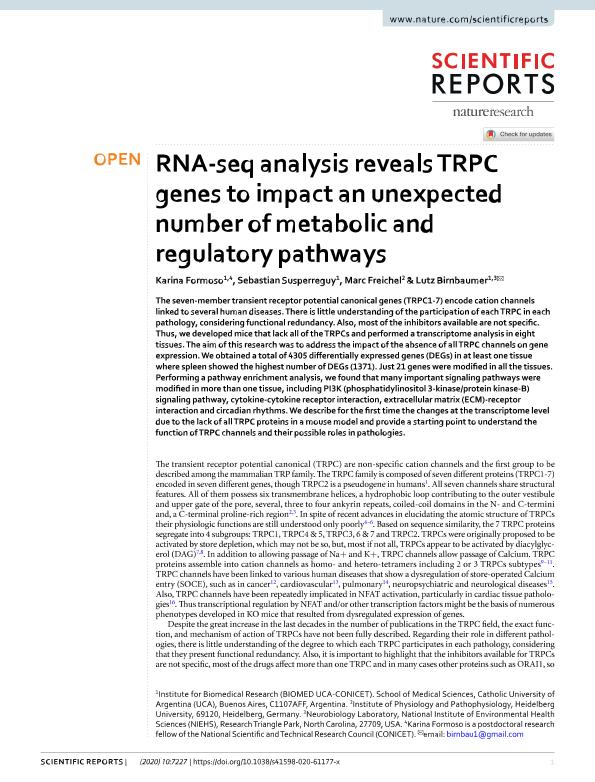Mostrar el registro sencillo del ítem
dc.contributor.author
Formoso, Karina

dc.contributor.author
Susperreguy, Sebastian

dc.contributor.author
Freichel, Marc
dc.contributor.author
Birnbaumer, Lutz

dc.date.available
2022-02-08T19:15:13Z
dc.date.issued
2020-05
dc.identifier.citation
Formoso, Karina; Susperreguy, Sebastian; Freichel, Marc; Birnbaumer, Lutz; RNA-seq analysis reveals TRPC genes to impact an unexpected number of metabolic and regulatory pathways; Nature; scientific reports; 10; 1; 5-2020; 1-20
dc.identifier.issn
2045-2322
dc.identifier.uri
http://hdl.handle.net/11336/151597
dc.description.abstract
The seven-member transient receptor potential canonical genes (TRPC1-7) encode cation channels linked to several human diseases. There is little understanding of the participation of each TRPC in each pathology, considering functional redundancy. Also, most of the inhibitors available are not specifc. Thus, we developed mice that lack all of the TRPCs and performed a transcriptome analysis in eight tissues. The aim of this research was to address the impact of the absence of all TRPC channels on gene expression. We obtained a total of 4305 diferentially expressed genes (DEGs) in at least one tissue where spleen showed the highest number of DEGs (1371). Just 21 genes were modifed in all the tissues. Performing a pathway enrichment analysis, we found that many important signaling pathways were modifed in more than one tissue, including PI3K (phosphatidylinositol 3-kinase/protein kinase-B) signaling pathway, cytokine-cytokine receptor interaction, extracellular matrix (ECM)-receptor interaction and circadian rhythms. We describe for the frst time the changes at the transcriptome level due to the lack of all TRPC proteins in a mouse model and provide a starting point to understand the function of TRPC channels and their possible roles in pathologies.
dc.format
application/pdf
dc.language.iso
eng
dc.publisher
Nature
dc.rights
info:eu-repo/semantics/openAccess
dc.rights.uri
https://creativecommons.org/licenses/by-nc-sa/2.5/ar/
dc.subject
TRPC
dc.subject
CALCIO
dc.subject
RNA-SEQ
dc.subject
TEJIDOS
dc.subject.classification
Bioquímica y Biología Molecular

dc.subject.classification
Ciencias Biológicas

dc.subject.classification
CIENCIAS NATURALES Y EXACTAS

dc.title
RNA-seq analysis reveals TRPC genes to impact an unexpected number of metabolic and regulatory pathways
dc.type
info:eu-repo/semantics/article
dc.type
info:ar-repo/semantics/artículo
dc.type
info:eu-repo/semantics/publishedVersion
dc.date.updated
2021-09-07T18:56:55Z
dc.journal.volume
10
dc.journal.number
1
dc.journal.pagination
1-20
dc.journal.pais
Estados Unidos

dc.description.fil
Fil: Formoso, Karina. Pontificia Universidad Católica Argentina "Santa María de los Buenos Aires". Instituto de Investigaciones Biomédicas. Consejo Nacional de Investigaciones Científicas y Técnicas. Oficina de Coordinación Administrativa Houssay. Instituto de Investigaciones Biomédicas; Argentina
dc.description.fil
Fil: Susperreguy, Sebastian. Pontificia Universidad Católica Argentina "Santa María de los Buenos Aires". Instituto de Investigaciones Biomédicas. Consejo Nacional de Investigaciones Científicas y Técnicas. Oficina de Coordinación Administrativa Houssay. Instituto de Investigaciones Biomédicas; Argentina
dc.description.fil
Fil: Freichel, Marc. Universität Heidelberg; Alemania
dc.description.fil
Fil: Birnbaumer, Lutz. Pontificia Universidad Católica Argentina "Santa María de los Buenos Aires". Instituto de Investigaciones Biomédicas. Consejo Nacional de Investigaciones Científicas y Técnicas. Oficina de Coordinación Administrativa Houssay. Instituto de Investigaciones Biomédicas; Argentina
dc.journal.title
scientific reports
dc.relation.alternativeid
info:eu-repo/semantics/altIdentifier/url/https://www.nature.com/articles/s41598-020-61177-x
dc.relation.alternativeid
info:eu-repo/semantics/altIdentifier/doi/http://dx.doi.org/10.1038/s41598-020-61177-x
Archivos asociados
